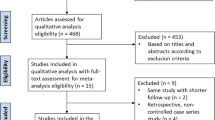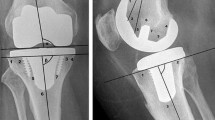Abstract
Purpose
Improvement of biomechanical properties of cobalt–chromium–molybdenum (CoCrMo) implant surface and reduction of adhesive wear is achieved by titanium–nitride (TiN) coating in vitro. Less pain, higher postoperative outcome scores and a lower revision rate after TKA with a TiN-coated CoCrMo TKA compared with uncoated CoCrMo TKA after 10-year follow-up was hypothesized.
Methods
In a double-blinded RCT, 101 patients received a cementless mobile-bearing CoCrMo TKA, either TiN-coated or uncoated. The primary outcome measure was the visual analogue scale (VAS) score for pain and secondary outcome measures were the Knee Society Score (KSS), Oxford Knee Score (OKS), revision rate and adverse events. Patients were assessed at 6 weeks, 6 months, 1 year, 5 years and 10 years, postoperatively.
Results
68 patients (67%) were available for 10-year follow-up. No difference was found in any of the assessed outcome measures with a mean decrease in VAS score (31.6 ± 22.9) and a mean increase in OKS (10.9 ± 8.4), KSS (29.3 ± 31.4), KSSK (26.4 ± 18.2) and KSSF (4.1 ± 22.9). Overall revision rate was 7% (coated 6% vs uncoated 8%) without additional revision procedures between 5 and 10-year follow-up.
Conclusions
The in vitro potential benefits of TiN coating did not result in better clinical outcome when compared to an uncoated cementless TKA. Pain, functional outcome and revision rates were comparable after 10-year follow-up. TiN-coated cementless TKA provides comparable good long-term results, similar to uncoated cementless CoCrMo TKA.
Level of evidence
Level 1, Therapeutic Study
Netherlands Trial Register
NL2887/NTR3033.




Similar content being viewed by others

References
Abane L, Anract P, Boisgard S, Descamps S, Courpied JP, Hamadouche M (2015) A comparison of patient-specific and conventional instrumentation for total knee arthroplasty: a multicentre randomised controlled trial. Bone Joint J 97-B:56–63
Abu-Amer Y, Darwech I, Clohisy JC (2007) Aseptic loosening of total joint replacements: mechanisms underlying osteolysis and potential therapies. Arthritis Res Ther 9:S6
Baker PN, Khaw FM, Kirk LMG, Esler CNA, Gregg PJ (2007) A randomised controlled trial of cemented versus cementless press-fit condylar total knee replacement: 15-year survival analysis. J Bone Joint Surg Br 89:1608–1614
Brander V, Gondek S, Martin E, Stulberg SD (2007) The John Insall award: pain and depression influence outcome 5 years after knee replacement surgery. Clin Orthop Relat Res 464:21–26
Breugem SJM, Linnartz J, Sierevelt I, Bruijn JD, Driessen MJM (2017) Evaluation of 1031 primary titanium nitride coated mobile bearing total knee arthroplasties in an orthopedic clinic. World J Orthop 8:922–928
Burnett RSJ, Barrack RL (2013) Computer-assisted total knee arthroplasty is currently of no proven clinical benefit: a systematic review. Clin Orthop Relat Res 471:264–276
Costa CR, Johnson AJ, Harwin SF, Mont MA, Bonutti PM (2013) Critical review of minimally invasive approaches in knee arthroplasty. J Knee Surg 26:41–50
Ewald F (1989) The Knee Society total knee arthroplasty roentgenographic evaluation and scoring system. Clin Orthop Relat Res 248:9–12
Fabry C, Zietz C, Baumann A, Ehall R, Bader R (2018) High wear resistance of femoral components coated with titanium nitride: a retrieval analysis. Knee Surg Sports Traumatol Arthrosc 26:2630–2639
Gallagher EJ, Liebman M, Bijur PE (2001) Prospective validation of clinically important changes in pain severity measured on a visual analog scale. Ann Emerg Med 38:633–638
Harman MK, Banks SA, Andrew Hodge W (1997) Wear analysis of a retrieved hip implant with titanium nitride coating. J Arthroplasty 12:938–945
Hawker G, Wright J, Coyte P, Paul J, Dittus R, Croxford R, Katz B, Bombardier C, Hech D, Freund D (1998) Health-related quality of life after knee replacement. J Bone Joint Surg Am 80:163–173
van Hove RP, Brohet RM, van Royen BJ, Nolte PA (2015) No clinical benefit of titanium nitride coating in cementless mobile-bearing total knee arthroplasty. Knee Surg Sports Traumatol Arthrosc 23:1833–1840
van Hove RP, Brohet RM, van Royen BJ, Nolte PA (2016) High correlation of the Oxford Knee Score with postoperative pain, but not with performance-based functioning. Knee Surg Sports Traumatol Arthrosc 24:3369–3375
van Hove RP, Nolte PA, Semeins CM, Klein-Nulend J (2013) Differences in proliferation, differentiation, and cytokine production by bone cells seeded on titanium-nitride and cobalt-chromium-molybdenum surfaces. J Biomater Appl 28:278–287
van Hove RP, Sierevelt IN, van Royen BJ, Nolte PA (2015) Titanium–nitride coating of orthopaedic implants: a review of the literature. Biomed Res Int 2015:485975
Insall JN, Dorr LD, Scott RD, Scott WN (1989) Rationale of The Knee Society clinical rating system. Clin Orthop Relat Res 248:13–14
Łapaj L, Rozwalka J (2020) Retrieval analysis of TiN (titanium nitride) coated knee replacements: Coating wear and degradation in vivo. J Biomed Mater Res B Appl Biomater 108:1251–1261
Łapaj L, Wendland J, Markuszewski J, Mróz A, Wiśniewski T (2016) Retrieval analysis of titanium nitride (TiN) coated prosthetic femoral heads articulating with polyethylene. J Mech Behav Biomed Mater 55:127–139
McMahon SE, Doran E, O’Brien S, Cassidy RS, Boldt JG, Beverland DE (2019) Seventeen to twenty years of follow-up of the Low Contact Stress rotating-platform total knee arthroplasty with a cementless tibia in all cases. J Arthroplasty 34:508–512
Mezger PR, Creugers NHJ (1992) Titanium nitride coatings in clinical dentistry. J Dentistry 20:342–344
Mohammed A, Metcalfe A, Woodnutt D (2014) Medium term outcome of titanium–nitride, mobile bearing total knee replacement. Acta Orthop Belg 80:269–275
O’Rourke MR, Callaghan JJ, Goetz DD, Sullivan PM, Johnston RC (2002) Osteolysis associated with a cemented modular posterior-cruciate-substituting total knee design: five to eight-year follow-up. J Bone Joint Surg Am 84:1362–1371
Peterson CD, Hillberry BM, Heck DA (1988) Component wear of total knee prostheses using Ti-6A1-4V, titanium nitride coated Ti-6A1-4V, and cobalt–chromium–molybdenum femoral components. J Biomed Mat Research 22:887–903
Postler A, Beyer F, Lützner C, Tille E, Lützner J (2018) Similar outcome during short-term follow-up after coated and uncoated total knee arthroplasty: a randomized controlled study. Knee Surg Sports Traumatol Arthrosc 26:3459–3467
Raimondi MT, Pietrabissa R (2000) The in-vivo wear performance of prosthetic femoral heads with titanium nitride coating. Biomaterials 21:907–913
Rice DA, Kluger MT, McNair PJ, Lewis GN, Somogyi AA, Borotkanics R, Barratt DT, Walker M (2018) Persistent postoperative pain after total knee arthroplasty: a prospective cohort study of potential risk factors. Br J Anaesth 121:804–812
Ritter MA, Lutgring JD, Davis KE, Berend ME, Pierson JL, Meneghini RM (2007) The role of flexion contracture on outcomes in primary total knee arthroplasty. J Arthroplasty 22:1092–1096
Sadoghi P, Leithner A, Weber P, Friesenbichler J, Gruber G, Kastner N, Pohlmann K, Jansson V, Wegener B (2011) Radiolucent lines in low-contact-stress mobile-bearing total knee arthroplasty: a blinded and matched case control study. BMC Musculoskelet Disord 12:142
Venkatesan M, Mahadevan D, Ashford RU (2013) Computer-assisted navigation in knee arthroplasty: a critical appraisal. J Knee Surg 26:357–361
(2019) England, Wales, Northern-Ireland and Isle of Man: National Joint Registry. 16th annual report . https://reports.njrcentre.org.uk/
(2019) Australian Orthopaedic Association National Joint Replacement Registry: annual report 2019. https://aoanjrr.sahmri.com/
(2019) Swedish Knee Arthroplasty Register: annual report 2019. https://www.myknee.se/en/
Funding
R. P. van Hove received funding from the Foundation of Orthopedic Research, Spaarne Hospital Hoofddorp, The Netherlands.
Author information
Authors and Affiliations
Corresponding author
Ethics declarations
Conflict of interest
The remaining authors declare that they have no conflict of interest.
Ethical approval
All procedures performed in studies involving human participants were in accordance with the ethical standards of the institutional and/or national research committee and with the 1964 Helsinki Declaration and its later amendments or comparable ethical standards. The study was approved by the Bioethics Committee of the VU University Medical Center Amsterdam (No. 2005/194). The trial was registered with the Netherlands National Trial Registry (NTR 3033).
Additional information
Publisher's Note
Springer Nature remains neutral with regard to jurisdictional claims in published maps and institutional affiliations.
Electronic supplementary material
Below is the link to the electronic supplementary material.
167_2020_5997_MOESM1_ESM.docx
Supplementary Figure A. Full study flow diagram. Number of patients assessed for eligibility, inclusion, randomization and allocation to either the intervention, TiN group or the control, CoCrMo group, lost to follow-up and analysis. TiN, titanium nitride-coated total knee prosthesis, CoCrMo cobalt–chromium–molybdenum total knee prosthesis, V1 visit 1 at 6 weeks, V2 visit 2 at 6 months, V3 visit 3 at 1 year, V4 visit 4 at 5 years, V5 visit after ten years. (DOCX 23 kb)
Rights and permissions
About this article
Cite this article
Louwerens, J.K.G., Hockers, N., Achten, G. et al. No clinical difference between TiN-coated versus uncoated cementless CoCrMo mobile-bearing total knee arthroplasty; 10-year follow-up of a randomized controlled trial. Knee Surg Sports Traumatol Arthrosc 29, 750–756 (2021). https://doi.org/10.1007/s00167-020-05997-4
Received:
Accepted:
Published:
Issue Date:
DOI: https://doi.org/10.1007/s00167-020-05997-4



